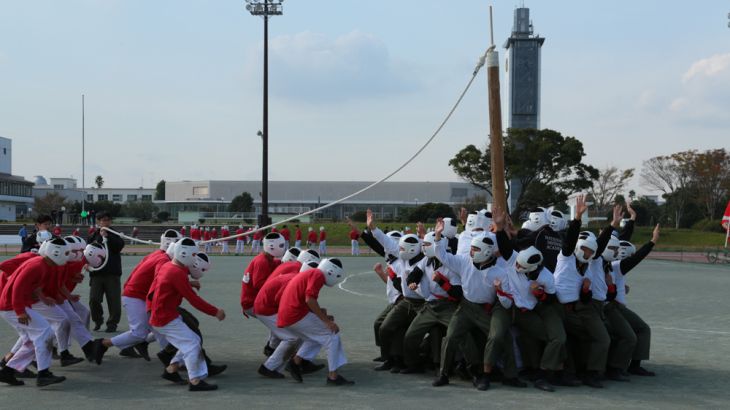
Japan’s War Game
In Japan’s elite military college, young cadets prepare for battle in a fierce sport steeped in history and tradition.
Every year cadets at Japan’s National Defense Academy prepare to battle each other in a fierce sport called Botaoshi.
Up to 300 players square off in an attempt to pull down a three-metre pole held upright by the opposing team.
Keep reading
list of 4 items‘Accepted in both [worlds]’: Indonesia’s Chinese Muslims prepare for Eid
Photos: Mexico, US, Canada mesmerised by rare total solar eclipse
What is a Godzilla anyway? The 70-year-old monster behind the movies
These young men are training to become future leaders in Japan’s Self-Defense Forces, and see the game as a test of their physical strength and strategic abilities.
With Japan recently passing new laws that allow its troops to fight overseas for the first time since World War II, the cadets are more determined than ever to excel.
Witness follows the captains of two Botaoshi battalions, each deploying different tactics to lead their team to victory.
FILMMAKER’S VIEW
By Nick Ahlmark
While growing up I was a big fan of American football documentaries from the 1960s and 1970s. They were always so epic and gripping, using lots of slow motion and emotive music. I wanted to capture a similar sense of excitement and unfolding drama in my documentary about Botaoshi, a traditional sport played at Japan’s National Defense Academy (NDA).
I was intrigued by the game’s military parallels and metaphors, with teams split between offence and defence, and an emphasis on reconnaissance and tactics that draw upon military terminology.
The visual spectacle of Botaoshi offered a host of creative possibilities but also technical challenges. We filmed the training sessions from as many angles as possible, often using three or four cameras, in order to give us the range of material needed for a dynamic and explosive edit.
Our main RED Dragon camera was usually on a tripod shooting 50 or 100 frames per second (ie, slow motion) and picking off a range of tight, mid and wide shots of the action. Our second camera was the Sony A7 II, a small and light DSLR. This was set up on a Ronin stabiliser, allowing us to run with the players and get fluid, sweeping shots on the field.
I also wanted the viewer to be immersed in the action from the point of view of the players. For this we attached GoPro Hero4 cameras to their helmets. We also used other techniques to capture the intensity of the matches, such as running alongside the players with a handheld RED Dragon for a grittier effect.
The final tournament was the most challenging to shoot. Understandably, the NDA did not allow media on to the field of play. There were only three spots where cameras were permitted: two on opposite corners of the field and one on the sidelines. Each of these areas had 15 to 20 camera people from international and domestic media, so our shooters had to get there quickly and jostle for the best position.
RELATED Feature: Japan’s opposition regroups to protect constitution
In each corner we had a shooter overseeing two cameras; one set up on a tripod with a long lens to capture tight action shots and a second locked off on a wide shot of the field. I was positioned on the side with a small DSLR to capture wide shots and crowd reactions. We also had a fourth roaming unit to shoot material away from the field, such as following players in the build-up and aftermath of matches.
It would have been easy to portray Botaoshi as a kind of freakish, weird game. However, I wanted to give it the respect attributed to any major sport, to capture the passion and dedication of the players, and unravel what it means in the context of their world and the changing domestic and geopolitical climate around them.
Follow Nick Ahlmark on Instagram: @ahlmarkable and check out his website: www.storytime-films.com
![Filming Japan's War Games [Nick Ahlmark / Al Jazeera]](/wp-content/uploads/2016/03/cc14668e62984e14bc4f6b469c2b0447_18.jpeg)